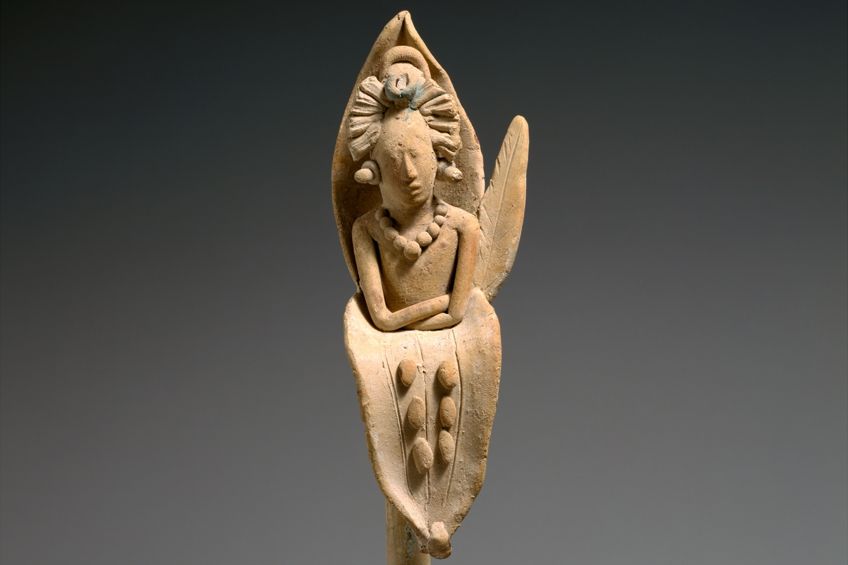Mayan Artifacts – A Window into Ancient Mayan Culture
Ancient Mayan artifacts are, aside from the architecture of this civilization, some of the only remaining pieces of this civilization that still exist. In this article, we will examine ten of these ancient Mayan artifacts, which include a variety of ceramics, carvings, and Mayan statues, so that we may better appreciate these ancient pieces of art. Keep reading to learn more about Mayan artifacts!
A Look at Ancient Mayan Artifacts
The Ancient Mayan civilization was one of the most powerful examples of a civilization of its kind within Mesoamerica. The people of this ancient civilization possessed a writing system, an intricate understanding of mathematics and astronomy, sophisticated architecture, and, of course, many stunning instances of art. We’ll be having a look at some of that art over the course of this article. So, let’s have a look.

Spouted Jar (Mid-1st Century BCE – 1st Century CE)
| Dimensions (cm) | 53 X 61 X 53 |
| Date | Mid-1st Century BCE – 1st Century CE |
| Materials Used | Limestone |
| Function | Container |
The Spouted Jar is a gorgeous container that is sculpted out of limestone that would have been used for chocolate. The idea behind the basic structure of this Mayan relic was that it could be used to blow air through the spout and thereby produce bubbles. These bubbles would then allow for the chocolate drink to become frothy.
This piece of Mayan pottery is carved with hieroglyphs and iconography representing various divine figures.
There’s a bird-like creature on one side of the spout, which is a fairly common feature in Mayan artifacts, and on the other side of the spout, there is a figure that has more human-like characteristics, but it has an image that is reminiscent of the Mayan Maize god because of the shape of the forehead, cheeks, teeth, and the jewels that are shown on the figure. This is a beautiful example of the kinds of early Mayan artifacts that this civilization produced.
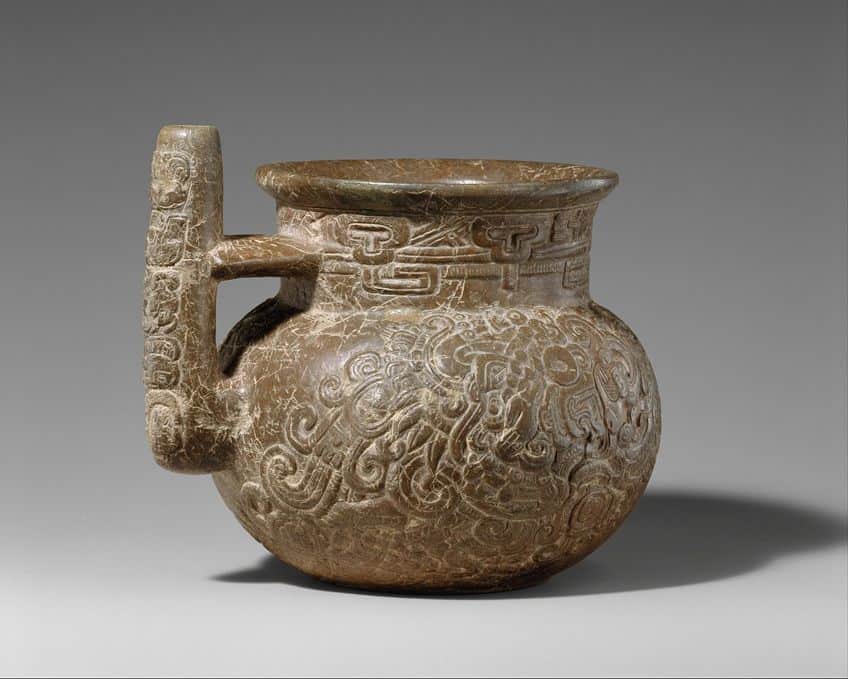
Censer, Seated King (4th Century CE)
| Dimensions (cm) | 80 X 31.1 X 22.9 |
| Date | 4th Century CE |
| Materials Used | Ceramic |
| Function | Incense burner |
The Censer of a Seated King is an incense burner that is made of ceramic and depicts a ruler of the Mayan people. This can be seen in the headdress that is worn on their head and through the jewelry that adorns them. The figure also holds what may be the representation of a mirror, and the Mayan relic, as a whole, is indicative of the Early Classic era of the Maya civilization. One of the most important aspects of this culture was the Mayan jaguar god that was so prevalently depicted in their artworks, and the Mayan jaguar symbol was especially used.
In this particular artifact, there are depictions of jaguar pelts that would have aided in solidifying the prestige of the one crafted into this incense burner.
Incense was a very important aspect of many Mayan rituals, and incense is actually still used to this day by many of the descendants of the ancient Mayan people. The general idea was that incense smoke would be used to communicate with both deities and ancestors, and the incense burners that were used were often sculpted into a variety of shapes that depicted important figures and ancestors. It was a sign of respect, but also a way of honoring those who had come before.

Carved Bowl (6th Century CE)
| Dimensions (cm) | 63 X 91 diameter |
| Date | 6th Century CE |
| Materials Used | Ceramic |
| Function | Container |
The Carved Bowl is a ceramic dish that is comprised of various images of feathered serpents with humanoid figures at their mouths. These images are quite common throughout Mayan art, and in this particular instance, they are undulating figures that move around the bowl as a whole.
The humanoid figures are believed to be the representations of characters that have come from the underworld, as serpents were associated with the underworld in Mayan mythology.

Head Pendant (6th – 9th Centuries)
| Dimensions (cm) | 8.6 X 5.5 X 1.8 |
| Date | 6th – 9th Centuries |
| Materials Used | Jade |
| Function | Pendant |
This Head Pendant is a jade pendant that was carved into a triangular shape, and it is a truly gorgeous example of the kinds of Ancient Mayan artifacts that were possible during this civilization’s height. This particular pendant depicts a humanoid face that is surrounded by a headdress with animalistic features. However, this is only the front side of this Mayan artifact.
The reverse side of the pendant features inscriptions.
These inscriptions proceed across two columns and five rows, and this short textual section gives two significant dates of a ruler who is currently unknown. These dates commemorate when this ruler became a ruler and also a celebration of their 20th anniversary. Jade is a very rare material, especially in ancient times, and so the pendant became worn down over the centuries as many different people would have touched the beautifully crafted Mayan relic. It stands as one of the most gorgeously rendered examples of Mayan artistry to date.
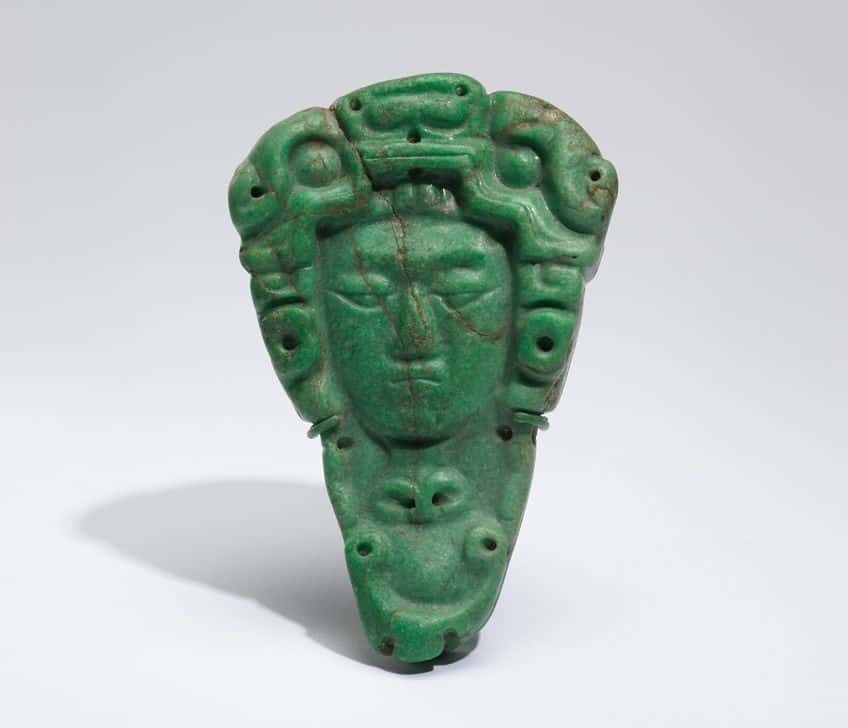
Seated Female Figure (6th – 9th Centuries)
| Dimensions (cm) | 18.2 X 12.7 X 8.9 |
| Date | 6th – 9th Centuries |
| Materials Used | Ceramic |
| Function | Figurine |
This Seated Female Figure is one of the most stunning examples of Mayan statues yet discovered. The figurine also served as a whistle of all things, and the mouthpiece is hidden in the figurine’s hair and the opening is on the right shoulder. So, there would have been a functional use for this small figurine, but it is now mostly noted as a gorgeous Mayan artifact that depicts a female figure in a seated position.
The female figure in question would have been a royal individual of some description, and she sits with her legs crossed, her hands resting on her shins, and she’s in an upright position.
She has cuffs made of beads, ear jewelry, and a necklace made of larger beads on her body, and her clothing appears to be a large piece of fabric that covers her entire body. We can also actually see the fingerprints of the sculptor who created this artifact throughout the figure, which is an interesting addition. These kinds of handcrafted ceramic figures were a common part of Mayan culture, and they often served as important aspects of Mayan funerary customs. This is one of the best examples of such a crafted figure that has managed to survive until the present day.
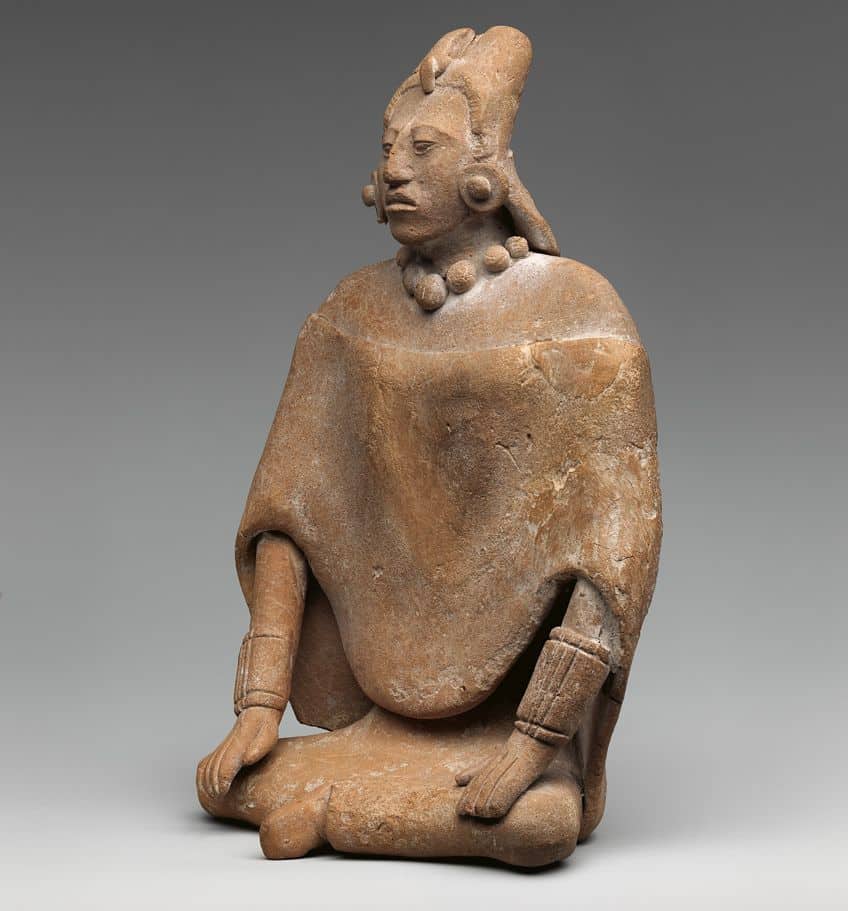
Censer Support (Mid-7th – 9th Centuries)
| Dimensions (cm) | 53 X 61 X 53 |
| Date | Mid-7th – 9th Centuries |
| Materials Used | Ceramic |
| Function | Incense holder |
The Censer Support is a ceramic incense holder that was part of a complete set that has since been lost. This particular cylindrical structure would have been used to hold up a bowl used for incense. This support structure was therefore created to be especially detailed in its depiction of the figure that adorns it.
This piece of Mayan pottery depicts a standing figure with large eyes beside two smaller figures wearing animal masks.
Animal masks and iconography in general were especially prominent in Mayan artifacts and art, such as the Mayan jaguar symbol. In this particular case, this Mayan artifact depicts these three figures atop a turtle shell, and turtles were said to be metaphoric representations of the earth.
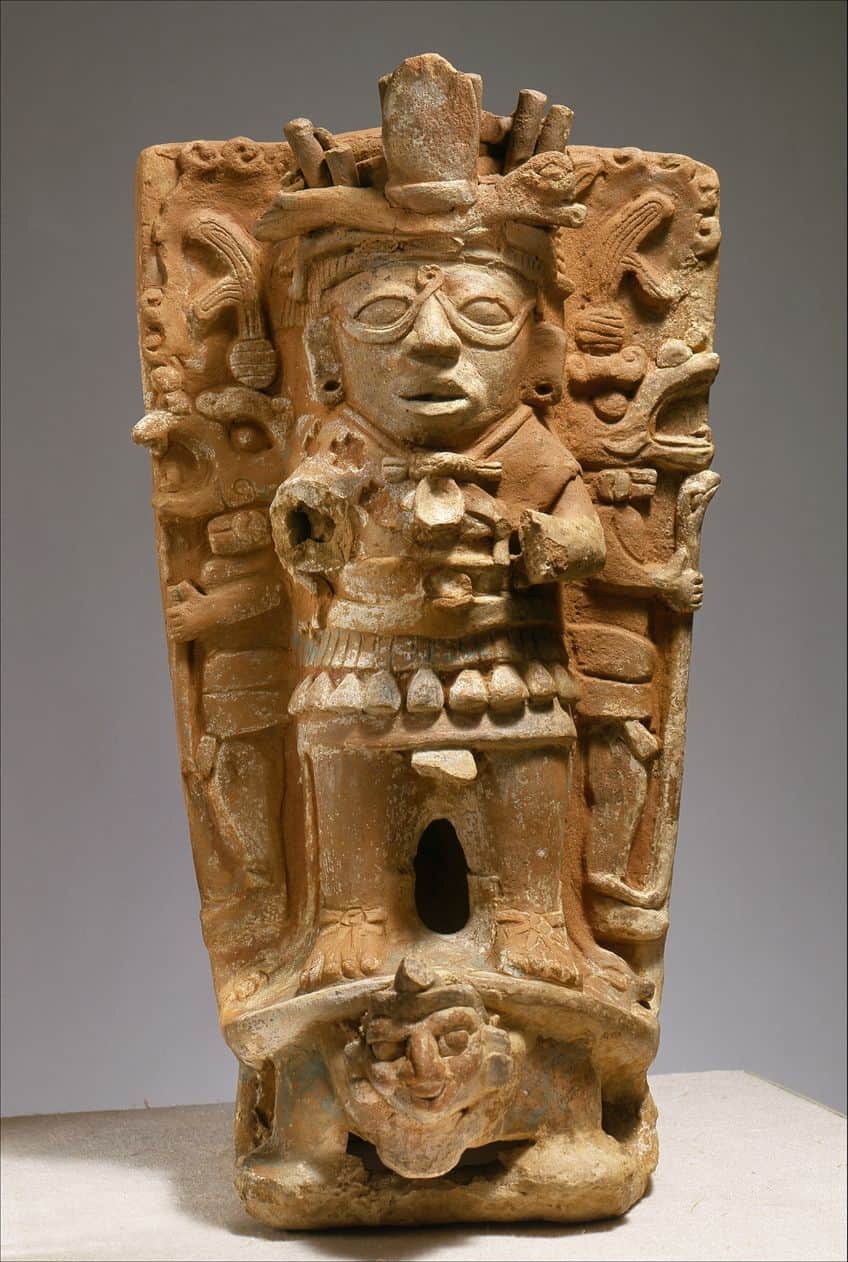
Maize God Emerging from A Flower (7th – 9th Centuries)
| Dimensions (cm) | 20.7 X 5.1 X 3.8 |
| Date | 7th – 9th Centuries |
| Materials Used | Ceramic |
| Function | Sculpture |
Maize God Emerging from A Flower is a beautiful example of a piece of Mayan art as it, as the name suggests, depicts a divine figure associated with maize climbing out of the husk of corn on the cob. The divine figure has idealized facial characteristics and the kind of elongated head that was common throughout the Mayan civilization.
The figure is depicted with crossed arms, a headdress, a necklace, and ear jewelry.
The depiction of the corn makes use of a long and narrow stem structure that has no adornments and is therefore far more naturalistic in its general depiction, and there is a leaf that asymmetrically projects from one side and not from the other. This is a rather delicate and beautiful example of the Mayan artifacts that this ancient civilization was capable of producing.

Relief with Enthroned Ruler (Early 770s)
| Dimensions (cm) | 88.9 X 87.6 X 7 |
| Date | Early 770s |
| Materials Used | Limestone |
| Function | Relief |
Relief with Enthroned Ruler was very probably a doorway lintel, and it is a relief panel that depicts three characters. There is one seated and two are standing. There is one standing figure that is offering a headdress to the seated figure, which is the representation of the ruler from that region, Tiloom.
Mayan artifacts of this description can often aid us in understanding the kinds of political systems that existed within these ancient civilizations by revealing the customs that were commonplace within them.

Chahk (9th Century)
| Dimensions (cm) | 215.6 X 61 X 50.8 |
| Date | 9th Century |
| Materials Used | Limestone |
| Function | Sculpture |
Chahk is an over 2 m tall Mayan statue that depicts the deity for which the statue is named. This deity was the personification of storms, rain, and lightning, and even though the statue as a whole is incomplete (it has a missing hand), it is still an immensely important example of the far larger sculptures that were possible at the time.
Furthermore, the entire statue was carved out of a single, large piece of limestone.
There were many such representations of Chahk during this late period in the Mayan civilization, and there are many elements within this particular example of these kinds of Mayan statues that have been found on other statues from other regions.

Head of a Rain God (10th – 11th Centuries)
| Dimensions (cm) | 53 X 61 X 53 |
| Date | 10th – 11th Centuries |
| Materials Used | Limestone |
| Function | Sculpture |
Head of a Rain God is a stunning piece of Ancient Mayan artistry. This is the statue of a head that depicts a divine being of some description, and it has been theorized that this is likely a rain god. The creature that has been depicted has large ears, a headband, long hair, and a forehead symbol that may have represented a jewel of some sort.
The head, which is all that remains of the statue as a whole, would have been part of either a building’s façade or it would have been a free-standing structure of its own.
These kinds of figures were frequently depicted in Mayan art as many deities fell under the purview of Mayan mythology as a whole, and in this particular case, the deity in question was likely believed to have a special eyesight that was different from the vision of a human. This can be seen in both the way in which the eyes are carved also because of the presence of red pigment in the eyes.
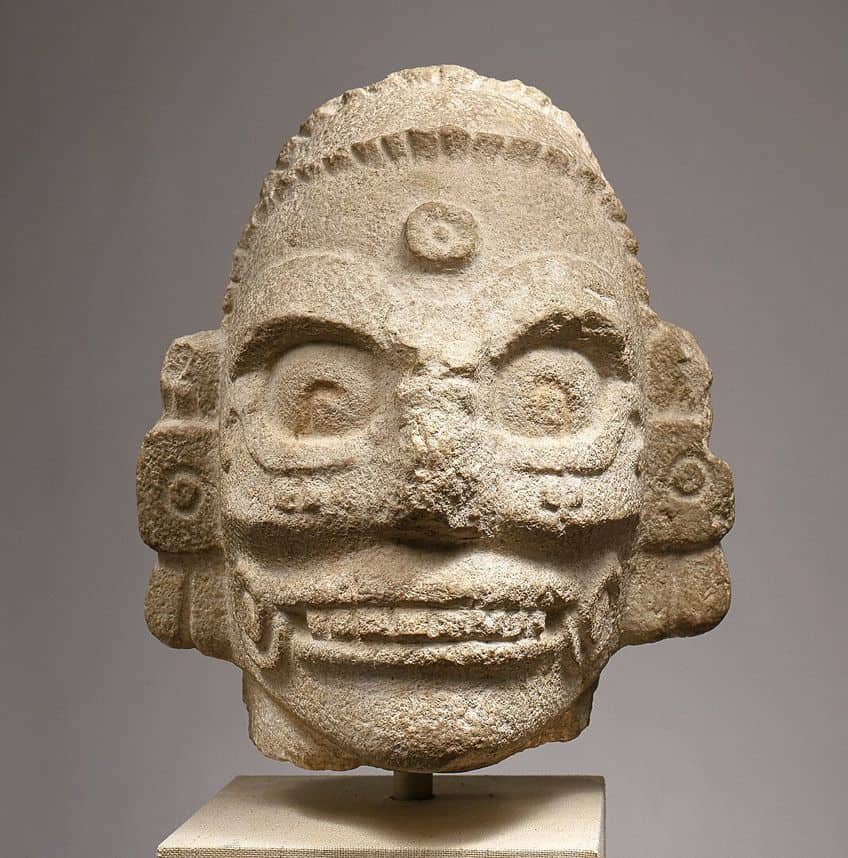
Furthermore, this particular example of the many Mayan statues that once covered their cities, is a work of art that blends several styles together. There is some evidence that this statue was from the Early Postclassic Period, in which the Maya interacted with the Toltecs in Central Mexico. But this cannot be definitively determined.
We have come to the end of our discussion about Ancient Mayan artifacts. We have examined ten such Mayan artifacts in an attempt to better understand them. There were pieces of pottery, statues, and other relics that we explored over the course of this article. So hopefully, you’ve learned a good deal about Mayan artifacts. Lastly, we wish you a great day/week/month ahead!
Frequently Asked Questions
Where Was the Mayan Civilization?
The Ancient Maya civilization was a civilization that existed within Mesoamerica and developed in parts of Central and South America. This ancient civilization could be found in parts of Mexico, Honduras, and El Salvador, and was also made up of the entirety of Guatemala and Belize. This civilization was not insignificant in its size, and it stood as a powerful empire until it was ultimately destroyed in the 17th century.
When Was the Mayan Civilization?
The Mayan civilization was a truly ancient one. Its earliest origins go back as far as 2000 BCE, but the earliest periods of city development began in about 750 BCE. Within two and a half centuries, these cities had monumental architecture. The Classic period began in about 250 CE and lasted until the 9th century, but this was an era of political collapse from which this civilization never fully recovered. The remaining cities fell to the Spanish in the 17th century. This marked the end of the Mayan civilization.
What Is a Mayan Artifact?
Mayan artifacts are any artifacts that originated from the Ancient Mayan civilization. Many of these Mayan relics depict iconography related to ancestors, the Mayan jaguar god, and various other images related to the culture in general. These artifacts were produced throughout the course of the civilization’s existence, and many of them still exist to this day.
Jordan Anthony is a Cape Town-based film photographer, curator, and arts writer. She holds a Bachelor of Art in Fine Arts from the University of the Witwatersrand, Johannesburg, where she explored themes like healing, identity, dreams, and intuitive creation in her Contemporary art practice. Jordan has collaborated with various local art institutions, including the KZNSA Gallery in Durban, the Turbine Art Fair, and the Wits Art Museum. Her photography focuses on abstract color manipulations, portraiture, candid shots, and urban landscapes. She’s intrigued by philosophy, memory, and esotericism, drawing inspiration from Surrealism, Fluxus, and ancient civilizations, as well as childhood influences and found objects. Jordan is working for artfilemagazine since 2022 and writes blog posts about art history and photography.
Learn more about Jordan Anthony and about us.
Cite this Article
Jordan, Anthony, “Mayan Artifacts – A Window into Ancient Mayan Culture.” artfilemagazine – Your Online Art Source. August 10, 2023. URL: https://artfilemagazine.com/mayan-artifacts/
Anthony, J. (2023, 10 August). Mayan Artifacts – A Window into Ancient Mayan Culture. artfilemagazine – Your Online Art Source. https://artfilemagazine.com/mayan-artifacts/
Anthony, Jordan. “Mayan Artifacts – A Window into Ancient Mayan Culture.” artfilemagazine – Your Online Art Source, August 10, 2023. https://artfilemagazine.com/mayan-artifacts/.


